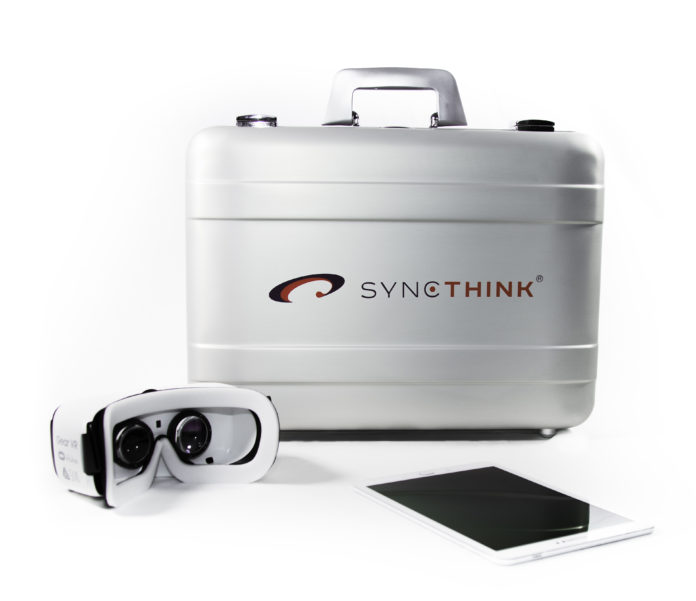SyncThink is helping football teams across the United States detect concussions symptoms with EYE-SYNC. The FDA approved and HIPAA compliant VR headset is equipped with eye-assessment hardware that identifies concussion symptoms on the field. It’s so helpful and easy to use that team doctors have athletes use the EYE-SYNC headset with a computer tablet, perform an eye tracking test, and in 60 seconds you’ll know if you’re in danger of having a concussion.
How EYE-SYNC Works
Dr. Jamshid Ghajar MD, Ph.D. is the Founder and Chief Scientific Advisor of SyncThink. He’s the genius who came up with the idea to mix eye tracking with virtual reality. Dr. Ghajar explains how using the Gear VR headset and brain-saving program together works.
In a Rule of Three article, he explains that “…we have VR glasses with a red dot going around a circle and cameras inside the glasses so you can actually see where the eyes are moving. We see how well the eyes synchronize with the visual stimulus, the dot going around the circle.” He says that in under a minute you’ll know whether or not a player should be withheld from going back on the field for further examination or allowed to return to the game.
Talking Openly About Concussions and CTE

A 2017 ESPN article reported that 177 former high school, college, and professional football players out of the 202 brains in a study had CTE or chronic traumatic encephalopathy. What was truly shocking about the study was that 90% of the brains studied belonged to players who were in the NFL.
CTE, according to the Concussion Legacy Foundation, is a degenerative disease of the brain that is found in people with repetitive head and brain trauma like football players who have to frequently undergo concussions and even multiple small impacts over time. Those suffering from it will experience headaches, memory loss, impulse control issues, anger, confusion, depressed mood, and other issues. At the worst, concussions and frequent hits to the head can cause brain damage, seizures, suicide, or an early death.

In a disturbing report to Congress, DeAndre Levy, a former Lions linebacker, explained that two people from his own team tried to silence him from speaking out about his diagnosis of football-related concussions and CTE, while doctors overprescribed medication to him.

Many other players, like Super Bowl champion Dave Duerson, were forced to stay silent in their physical pain and mental struggles caused by CTE and eventually succumbed to the brain disease through suicide.
With this said, it’s important to see how lifesaving SyncThink’s 60-second EYE-SYNC program can truly be for athletes.
Universities Use EYE-SYNC
Football teams from The University of Texas, Iowa State University, and many others are now using the SyncThink VR headset with EYE-SYNC to treat their student-athletes on the football field post-impact.

Scott Anderson, SyncThink’s CCO and former Director of Athletic Training at Stanford University, explained the lifesaving change the University of Texas took to protect the health and lives of their student-athletes. He explains that using the VR headset and the concussion detecting program is “…providing them with key insights to measure, identify, and resolve disorientation in order to ensure a safe return to practice and play.” Using EYE-SYNC not only protects players from going back into a game that may injure them more, but it also gets players back in the game if they are safe to do so.

Other colleges like Iowa State are using the SyncThink gear in two places — fieldside and in recovery. In an Iowa State article, Mark Coverley, the Director of Sports Medicine and the Associate Athletics Director at Iowa State, explained how clinicians and trainers are better equipped to “determine appropriate return to play decisions, and as importantly, target and evaluate identified areas of dysfunction that can be addressed more effectively during the recovery process.” Having an accurate reading of athlete’s eye movement helps coaches, clinicians, and sports trainers have a better idea of what approach to a treatment they should take and whether or not they need to get to a hospital.
In the same article, Scott Anderson also explained that the SyncThink gear can be utilized in recovering from a concussion. He says, “I’m excited for [the university] to see the value our technology will bring to their sidelines and injury clinic, and most importantly to know their student-athletes will be comforted by seeing objectively how their impairments resolve with appropriate treatment, ensuring [a] safe return to sport.”
Hope On The Horizon

Football is a popular and violent game, but if football players are being treated ethically, being given appropriate treatments and diagnostics, and informed of their health status clearly, the more likely these players will keep thriving.
It’s exciting to see how SyncThink and EYE-SYNC are helping coaches, trainers, and doctors tackle concussions and CTE directly, while potentially saving a nation of professional and student-athletes.



Comments are closed.